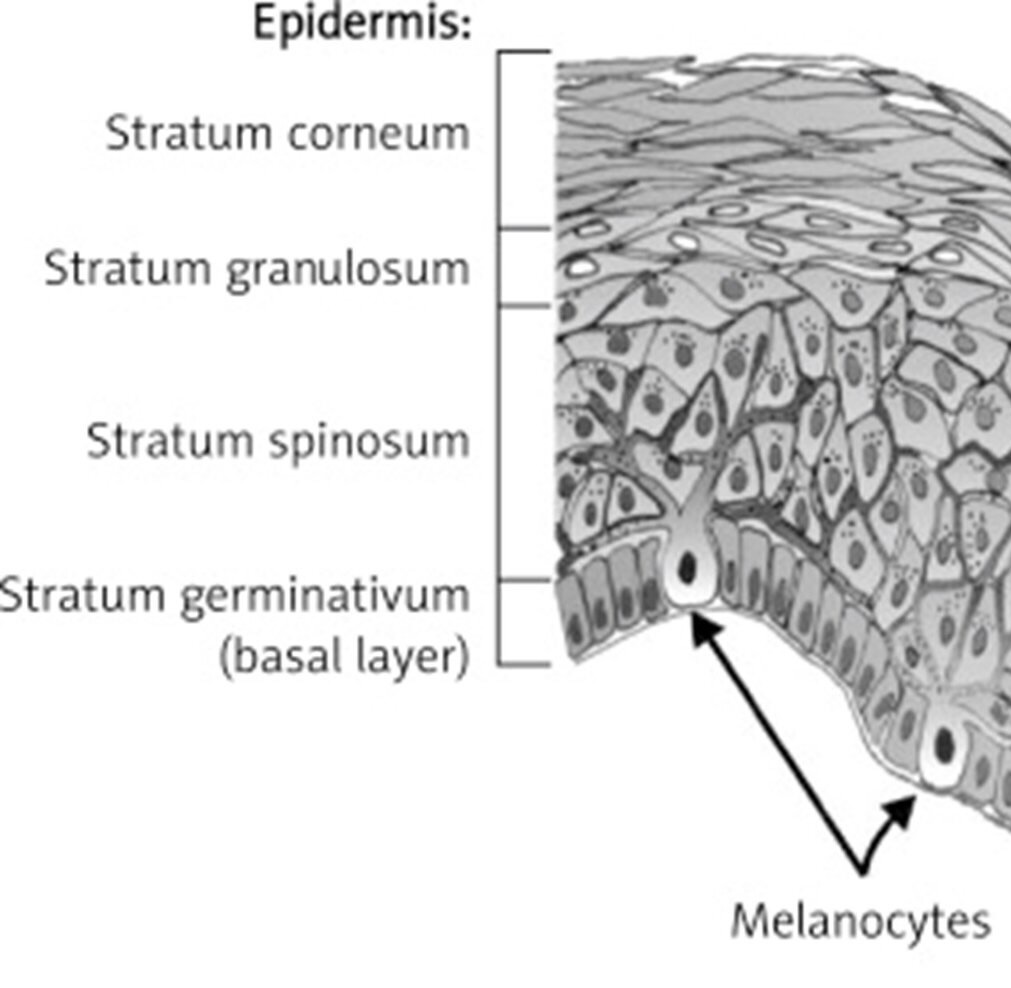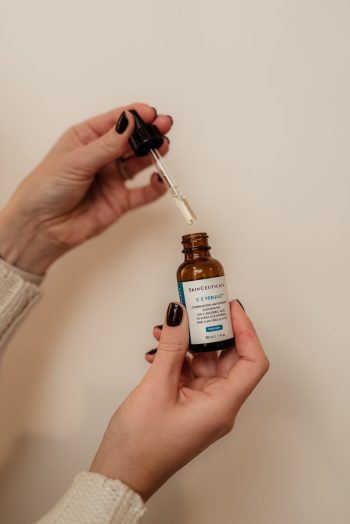BLUR NEWS
APRIL 2023 VOL. 04

Hyperpigmentation
AKA: Melasma, Age Spots, Acne Scars
Hyperpigmentation is the broad clinical term used to describe uneven discoloration of the skin.
Hyperpigmentation can present as brown, red and tan in color, as well as range in size and develop anywhere on the body. The source, or biology, of hyperpigmentation differs per ethnicity and race, but are all as a result of damage to the skin’s DNA. Which means hyperpigmentation is not something we’re born with, but rather the damage to the skin’s DNA causes it to produce more melanin which leads to discolored spots. Forms of damage include burns, sun exposure, bruises, acne, rashes, hormones or other trauma.
When hyperpigmentation is present on our face, it can often channel a negative emotional reaction and weigh heavily on our self confidence; not to mention it is often highly difficult to treat. It’s important to note that hyperpigmentation cannot be cured, but rather the management of it- often multimodal, causes it to improve, often to the point of disappearing. However, once the treatment of hyperpigmentation is discontinued, or no longer managed, it will return.
THE QUICK TAKEAWAYS
HYPERPIGMENTATION IS THE BROAD MEDICAL TERM USED TO DESCRIBE DISCOLORATION OF THE SKIN
CAN PRESENT AS BROWN, RED, OR TAN AND RANGE IS SIZE/LOCATION BUT ARE ALL CAUSED BY DAMAGE TO THE SKIN’S DNA
HYPERPIGMENTATION CANNOT BE CURED, BUT RATHER MANAGEMENT OF IT CAUSES IT TO IMPROVE, OFTEN DISAPPEARING. IT WILL RETURN WHEN MANAGEMENT IS DISCONTINUED
CHECK OUT BELOW FOR MORE INFORMATION ON MULTIMODAL TREATMENT OPTIONS FOR HYPERPIGMENTATION
A quick dive into the science behind hyperpigmentation:
There are three main layers to the skin: The epidermis, which is the outermost layer, the dermis, the middle layer, and the hypodermis or subcutaneous layer which is the deepest layer and houses our fat cells. We’re going to focus on the epidermis, which is then again broken down to four other layers, specifically its “basement” layer or deepest layer of cells is called the basal layer- this is where our melanocytes live. Melanocytes are responsible for producing melanin pigments. The ratio in which these pigments are present in the skin results in the vast diversity of human skin color. Besides providing color to our skin.
Tmelanin also aids in skin production when the skin is experiencing trauma- such as extended exposure to UV rays, residual acne scars, skin infections or hormonal changes such as during pregnancy. When the melanin does not evenly distribute, they can aggregate together to form a patch. These patches result in visible birthmarks, freckles or age spots on the skin; AKA hyperpigmentation. The unfortunate reality of all of this is that the majority of skin damage occurs before people are the age of 18. For many this means well before they are concerned about the long-term results of visible hyperpigmentation can cause later in life.

Hyperpigmentation treatments and management:
Does this sound like something you’ve dealt with, or currently deal with? Know you’re not alone. Hyperpigmentation is easily the most common skin concern, following wrinkle reversal/reduction, expressed by BLUR patients during consultations. So how do we treat hyperpigmentation if it can’t be cured? Through unique management, often multimodal, a targeted treatment approach can help spots fade, and help prevent discoloration from returning.
- Facial Acids
Incorporating topical facial acids is often a simple step for clients to build into their skincare routine to help treat hyperpigmentation. Acids work by chemically exfoliating the top layer(s) of your skin. Exfoliation prompts new skin cells to emerge, replacing the old, which evens skin tone and provides a smoother appearance.
Popular facial acids include:
- Vitamin-C (l-ascorbic acid)
- Beta-Hydroxy-Acid (BHA) or salicylic acid
- Alpha-Hydroxy-Acid (AHA) or glycolic acid
Facial acids are best suited for clients with mild hyperpigmentation, fairer skin tones, or those just looking to boost their skin’s radiance, tone and texture.
BLUR Products:
- C E Ferulic
- AHA/BHA Exfoliating Cleanser

2. Lightening Agents
In the form of a cream or serum, lightening agents contain select ingredients that have been researched and found to scientifically decrease pigmentation. Easily added into a clients at home skincare routine, lightening agents are a great additive for clients suffering from hyperpigmentation.
- Lightening agent examples:
- Niacinamide
- Phytic acid
- Tranexamic acid
- Lotus sprout extract
Lightening agents work best for clients suffering from flat discoloration, such as redness, melasma, age or sun spots.
BLUR Products:
- Even & Correct Advanced Brightening Serum
- Even & Correct Dark spot cream
- Even & Correct Brightening Treatment Pads
- Lytera Pigment Correcting Serum TNS Advanced Serum
- Scar Recovery Gel
- Instant Bright Eye Cream
- Lumivive System
3. Retinoids
A derivative of vitamin A, its smaller molecule size allows it to penetrate deeper into the skin treating the layers below the epidermis. Different from an exfoliant, retinoids are an antioxidant. Instead of stripping your skin of dead skin cells to show new cells, like an exfoliant, they actually encourage skin cells to turn over at a faster pace generating new skin cells. They renew our skin cells from within, protecting collagen by fighting off free radicals, and stimulate new collagen and elastin. This process plumps the deeper layers of our skin, which reduces fine lines, wrinkles and pore sizes.
Popular retinoids:
- Tretinoin
- Retinal
- Retinol
Retinoids are a great option for clients with multiple skin concerns, and clients should make room for incorporating along with their facial acids.

Using a stronger concentration of acid compared to topical facial acid serums and exfoliants, these are more powerful and thus yield quicker intensified results. Chemical peels are great for clients experiencing mild to moderate hyperpigmentation, such as age spots, sun damage, melasma or blotchy skin.
BLUR Services:
- Micropeel Sensitive (12% glycolic acid, 8% lactic acid, 2% phytic acid)
- Micropeel 30+ (30% salicylic acid)
- Advanced Corrective (14% salicylic acid, 14% lactic acid, 10% phenylethyl resorcinol)
A form of mechanical exfoliation, a medical grade device (SkinPen at BLUR) with 14 small sterile needles repeatedly punctures the skin creating a controlled injury. With the ability to control the depths of the needles to target different skin concerns, the needles prompt the skin to engage its wound healing process. This triggers cellular turnover, allowing new cells to replace the damaged/hyperpigmented ones, along with increasing collagen and elastin. Microneedling allows topical serums and creams to be better absorbed, allowing clients to achieve better results. Microneedling is especially effective for clients suffering from hyperpigmentation and textural irregularities from post-inflammatory hyperpigmentation such as acne scarring, stretch marks, or scarring.
BLUR Services:
- Microneedling
- Microneedling + Neck
- Microneedling with PRP
- Mirconeedling + Neck with PRP

Know you have hyperpigmentation, but don’t know where to start treating it? Tried over the counter, drugstore or makeup retailer products without results? We know the feeling. It’s easy to get overwhelmed, and feel bamboozled by all of the products on the market claiming to treat discoloration. Our nurse injectors are ready to help you tackle your hyperpigmentation with a tailored, obtainable treatment plan designed to fit any budget. We can’t wait to see you.
xoxo,
BLUR Aesthetics
